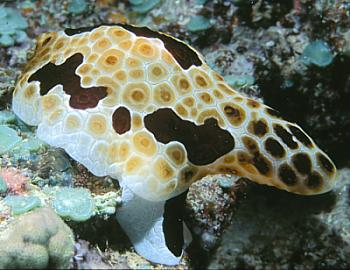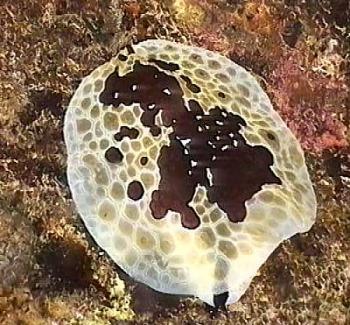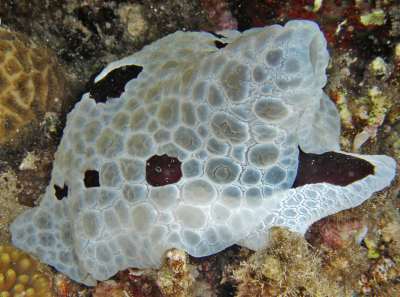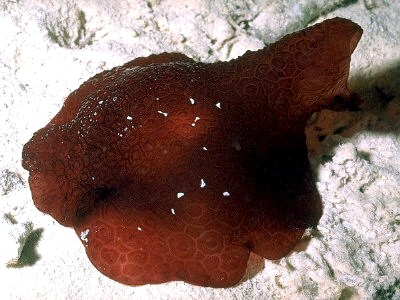

Pleurobranchus grandis
Pease, 1868
Order: NOTASPIDEA
Superfamily: PLEUROBRANCHOIDEA
Family: Pleurobranchidae
DISTRIBUTION
Indo-West Pacific
PHOTO
UPPER: Fiji, 10m, May, 1991. Approx 20 cm long. Photo: Mary Jane Adams.
LOWER: Russell Island Group, Solomon Ids. 3 m. Photo: Bruce Potter.
This large widespread Indo-West Pacific species is quite variable in colour, ranging form almost completely dark brown to white with pale brown spots. It usually can be described as white with large elongate brown patches. Like most large species of Pleurobranchus the mantle surface consists of rounded polygonal tubercles outlines by a reticulate pattern of white. The polygons in the white region are usually tipped with a diffuse pale brown. In living specimens the posterior part of the mantle is often held erect and folded into a posteriorly facing siphon [see upper photo]. It can grow to 20cm or more.
Reference:
• Pease, W.H. (1868). Descriptions of marine Gasteropodae, inhabiting Polynesia. American Journal of Conchology, 4(2): 71-80, Pls. 7-10.
Rudman, W.B., 2001 (January 1) Pleurobranchus grandis Pease, 1868. [In] Sea Slug Forum. Australian Museum, Sydney. Available from http://www.seaslugforum.net/find/pleugran
Related messages
Pleurobranchus grandis from Reunion Island
September 22, 2008
From: Hugues Flodrops


Dear Bill,
Here is a big pleurobranch: length about 180-200 mm. My best guess is Pleurobranchus forskalii without white semi-circle. Can you confirm this hypothesis? We can see the large gill on the posterior view, on the right side of the body.
Locality: Passe de l'Hermitage, 1,5 metre, Reunion, Indian Ocean, 28 December 2007, Night. Length: 180-200 mm. Photographer: Hugues Flodrops.
Thanks for your help.
Best regards.
Hugues.
hugues.flodrops@wanadoo.fr
Flodrops,H., 2008 (Sep 22) Pleurobranchus grandis from Reunion Island. [Message in] Sea Slug Forum. Australian Museum, Sydney. Available from http://www.seaslugforum.net/find/21376
Dear Hugues,
This is a very dark purple-brown form of Pleurobranchus grandis. The shape of the compound tubercles on the mantle and the way the posterior part of the mantle is often formed into a posteriorly pointing exhalent siphon, is quite characteristic of the species. Your photo alongside shows the gill, which is usually completely hidden on the right side of the body below the mantle. Fresh sea-water is drawn in anteriorly then flow backwards over the gill and then out the posterior siphon.
Best wishes,
Bill Rudman
Re: Pleurobranchus from Hurghada, Red Sea
February 4, 2008
From: Binyamin Koretz

Concerning message #21348:
Dear Bill,
Glad to hear you're getting over your illness.
We've seen the same small pleurobranch here in Eilat (at the northern tip of the Red Sea, for those unfamiliar). I can't find where we recorded the size but 3 cm sounds about right.
We didn't think it was a juvenile P. grandis because we've seen P. grandis as small as 5 cm and they looked exactly the same as the adults, only in miniature. Also this one is lacking the polygonal etching around the tubercles. The same can be said for the small P. mamillatus or small P. forskalii we've observed - they're all like miniature adults.
We saw it only once a couple of years ago, and at a site where P. grandis, incidentally, is not uncommon, so if it's not P. grandis perhaps they share a food preference.
Locality: Eilat, Caves, 3 m, Israel, Red Sea (Gulf of Eilat), February 2006, corals. Length: ca. 3 cm. Photographer: Binyamin and Shulamit Koretz.
Best regards
Binyamin
binyamin@koretz.net



Dear Binyamin,
Thanks very much for the further information. I could be quite wrong, but it seems a number of pleurobranchs do start as purple spotted and I am pretty sure the one I photographed in an earlier message [#13705] is P. grandis. That is not to say your Red Sea animal is different.
If it is distinct then I suspect ther is an early name from Polynesia for it - Pleurobranchus tessellatus - which Pease described with an illustration by Andrew Garrett in 1868. I have copied the image alongside [Plate 9, figure 4 - Pease, 1868]
It's a bit hard when this 'species' or 'colour form' only turns up occasionally, because we would need to examine is anatomy to see if it was mature, and'or anatomically different from other species. At present I will leave it with P. grandis, not because I disagree with your doubts, but because I think it will be easier to find here. If anyone has photos of similar animals they would be very welcome
- Pease, W.H. (1868) Descriptions of marine Gasteropodae inhabiting Polynesia. American Journal of Conchology. 4 (2): 71-80
Best wishes,
Bill Rudman
Pleurobranchus from Hurghada, Red Sea
January 31, 2008
From: Sven Kahlbrock


Hello Bill,
I found this nice species today; - probably a Pleurobranchus. A similar picture is in the Debelius / schneckenführer indopacific book, where he calls it P. spec., but it should only be common in the Andaman Sea/ Thailand.
Locality: El Fanadir Foc, Hurgada, 12 m, Egypt, Red Sea, 26 january 2008, at a rock. Length: 30 mm. Photographer: Sven Kahlbrock.
Sven Kahlbrock
s_kahlbrock@web.de
Kahlbrock, S., 2008 (Jan 31) Pleurobranchus from Hurghada, Red Sea. [Message in] Sea Slug Forum. Australian Museum, Sydney. Available from http://www.seaslugforum.net/find/21348
Dear Sven,
I am pretty sure this is a juvenile Pleurobranchus grandis. Have a look at my photo in an earlier message [#13705] of a similar animal which I identified as a juvenile of that species. P. peroni has similar purple spots when it is a juvenile [see Fact Sheet] but P. grandis has a ring of small tubercles around each of the large ones. Although these secondary tubercles aren't clear in your photos, I suspect the yellow-orange ring around each purple spot is an indication of them. Another distinctive feature of P. grandis is the large funnel-like fold formed at the back of the mantle in adults. In your photos we can see a similar fold is present even in even quite small animals.
I am sorry I can't comment on Debelius's new book as I haven't seen it. I assume that 'P. spec' just means 'an unidentified species of Pleurobranchus'. I am afraid you can't take much notice of locality data in photo books like that as usually the locality is just the place the photo was taken or where the author has seen it. It may not be the known geographic range of the species. If you follow messages on the Forum for long you will see that through the help of many pairs of eyes, we are extending the know geographic range of many species on a regular basis, so even data in well researched books often needs to be revised quite quickly.
Best wishes,
Bill Rudman
Pleurobranchus grandis from Indonesia
February 15, 2007
From: Mirjam Broos

Dear Bill,
While diving in Sulawesi we found a few Pleurobranchus but I'm not sure what species they are. Can you help me with the ID please. I think this might be P. grandis
Locality: Nudi Falls, Lembeh Strait, North Sulawesi, Indonesia, 08 october 2006, muckdiving. Photographer: Geert Prast.
Thanks,
Mirjam
mirjam.broos@planet.nl
Broos, M., 2007 (Feb 15) Pleurobranchus grandis from Indonesia. [Message in] Sea Slug Forum. Australian Museum, Sydney. Available from http://www.seaslugforum.net/find/19436
Dear Mirjam,
Yes this is one of the colour forms of P. grandis. This colour form is usually found in smaller specimens so it may be a juvenile colour form. The close-up alongside shows the arrangement of small tubercles in a ring around a large central tubercle.
Best wishes,
Bill Rudman
Re: Mystery slug from Malaysia
October 30, 2006
From: Michael Smith

Concerning message #13735:
Yes, that certainly looks like what I remember. I stopped seeing them after that season but recently we've been seeing another coloration of maybe the same species. I've attached one photo of him with some hitchhikers getting a lift.
Thanks! (and thank you to Jimmy too).
Michael Smith
msmith_sg@yahoo.com
Smith, M., 2006 (Oct 30) Re: Mystery slug from Malaysia. [Message in] Sea Slug Forum. Australian Museum, Sydney. Available from http://www.seaslugforum.net/find/17996Dear Michael,
In answer to your earlier message [#9456] I suggested your animals could be Pleurobranchus forskalii or P. grandis. Jimmy's photo [#13735] is most probably P. forskalii, but the photo you have sent this time is most definitely of P. grandis. It's more than possible that you have been seeing both species, but as this correspondence illustrates, it is very difficult to be 100% sure without photos, especially in species with a variable colour pattern.
Best wishes,
Bill Rudman
Pleurobranchus grandis from sthn Queensland
April 5, 2006
From: Ian Banks

I was hoping someone might be able to identify this Pleurobranchus.
It was working it's way around a rock pile. Have seen Pleurobranchus peroni many times but this is first sighting of this fellow.(over 300 dives in this area). I didn't take a lot of note on the size but approx. 30 mm
Locality: Gold Coast Seaway, 8 metres, Queensland. Australia, Pacific, 12 March 2006, Sandy rock pile. Length: 30 mm approx. Photographer: Ian Banks.
What do they feed on?
Regards,
Ian
ianbanks@bigpond.com
I.W.Banks, 2006 (Apr 5) Pleurobranchus grandis from sthn Queensland. [Message in] Sea Slug Forum. Australian Museum, Sydney. Available from http://www.seaslugforum.net/find/16238Dear Ian,
I have identified this colour form as a juvenile Pleurobranchus grandis in an earlier message [#13705]. The small size of your animal certainly supports that theory. Concerning what they eat. I am afraid we don't know the food of many sea slugs and this is another example. Some species of Pleurobranchus feed on ascidians so it is possible that this species does as well.
Best wishes,
Bill Rudman
Pleurobranchus grandis from the Red Sea
May 19, 2005
From: Oren Lederman


Hi Bill,
Here are some more photos of Pleurobranchus grandis. There were 3 of them, with a slightly different range of color. Spotted by my talented dive buddy.
Locality: The "Caves", Eilat bay, Israel. Red Sea. Depth: ~6 meters. Length: ~20cm. 15 April 2005. corals. Photographer: Oren Lederman
Oren Lederman
lederman@bigmail.co.il
Lederman, O., 2005 (May 19) Pleurobranchus grandis from the Red Sea. [Message in] Sea Slug Forum. Australian Museum, Sydney. Available from http://www.seaslugforum.net/find/13788
Thanks Oren,
The photo alongside is quite interesting as it shows how the posterior part of the mantle in this species often folds over to form a tube or siphon. When sitting like this is looks quite like the slug-like snails of the family Velutinidae, but in those animals the siphon is at the front end of the body.
Best wishes,
Bill Rudman
Pleurobranchus grandis eggs ribbon?
May 13, 2005
From: Oren Lederman

Hi Bill,
Last weekend my dive buddy spotted what appears to be an egg ribbon. I found it near a Pleurobranchus grandis, and because of the ribbon's size I guess it belongs to the Pleurobranchus grandis.
Locality: "The Caves", Eilat. Israel. Red Sea. Depth: ~4-5 m. Length: ~25 cm. 15-April-2005 (night dive). Photographer: Oren Lederman
Oren Lederman
lederman@bigmail.co.il



Dear Oren,
I am not a 100% sure its an egg ribbon, although there do seem to be tiny specks in the close-up alongside. One possibility is a brown algae like Colpomenia. If it is an egg ribbon I'm afraid the only way to positively identify it is to see it being produced. Your photo of Pleurobranchus grandis is quite useful as I have just been discussing the ring of small tubercles which surround the large tubercles [see Erwin Koehler's message #13751]. Your photo shows them very well.
Best wishes,
Bill Rudman
Juvenile Pleurobranchus grandis from nthn NSW
May 13, 2005
From: Bill Rudman

To accompany my comments on Erwin Koehler's message [#13751] , here is a photo of an animal I collected 20 years ago in northern new South Wales, which I consider to be a juvenile of Pleurobranchus grandis. One feature wjhich seems characteristic of the species is the ring of small tuberclues which surround each large tubercle.
Locality: Angourie, northern New South Wales, 11 March 1982. 55mm long alive. AM C132979. Photo: Bill Rudman
The foot was an orange brown with reddish spots along the edge. At the posterior end of the foot the reddish spots merged to form a continuous red band at around the posterior tip.
Bill Rudman
Rudman, W.B., 2005 (May 13) Juvenile Pleurobranchus grandis from nthn NSW. [Message in] Sea Slug Forum. Australian Museum, Sydney. Available from http://www.seaslugforum.net/find/13705Pleurobranchus sp. from the Philippines
May 13, 2005
From: Erwin Koehler

Dear Bill,
Now I am back at Germany and got a lot of no-ID shots. Please help!
Locality: Calangaman Island, Philippines. Depth: 11 m. Length: 41 mm. 13 March 2005. under dead corals. Photographer: Erwin Koehler
Cheers Erwin
www.Philippine-Sea-Slugs.com
Erwin@Philippine-Sea-Slugs.com


Dear Erwin,
I am pretty sure this is Pleurobranchus grandis. One characteristic of the species is how the large tubercles are surrounded by a ring of small tubercles. The small tubercles are not do clear in your animal but in the close-up I have arrowed a circular ridge around each tuberce which I think is what's left of the ring of small tubercles.
I have posted a photo of a juvenile [#13705] from New South Wales, which looks very like your animal and has quite a distinct circle of small tubercles.
The again I could be quite wrong ...
Best wishes,
Bill Rudman
Red Sea Pleurobranchus
February 2, 2005
From: Binyamin Koretz

Dear Bill,
From March to June 2004 we encountered a number of fairly large pleurobranchs that don't fit the Pleurobranchus grandis description, in that they lack the posterior siphon (broad tail-like extension) and the coloration is more red than brown. Also, these slugs are smaller (12-15 cm) than the P. grandis (up to 25cm!) that we see here in Eilat.
What they have in common is that they all have red rings of polygonal tubercles around the grandis-like dark-tipped tubercles, and they were all observed at the same dive site, at various depths (4 to 22 m).
I'm attaching photos of 3 individuals out of the 7 we photographed, to give you an idea of the range of color and markings.
In the same 2004 season, we photographed 17 'typical' P. grandis specimens, 2 at this dive site and the other 15 at a 2nd site several km away.
What do you think of these?
Locality: Village Beach, Eilat, Israel, Red Sea. Depth: 4 to 22 m. Length: up to 15 cm. Mar 2004 to Jun 2004. rubble slope, small coral pinnacles, seagrass. Photographer: Binyamin and Shulamit Koretz
Best regards
Binyamin
binyamin@koretz.net


Dear Binyamin,
I think these are all small? juvenile? examples of Pleurobranchus grandis. The posterior siphon is often not developed in smaller animals. The colour range certainly fits the range found in this species. Michael Mrutzek's photos show the siphon in similarly coloured animals to yours [message #10039],
I could of course be wrong, so all I can say is keep a watch on the population and see if you can see some of these siphon-less ones developing a siphon, or see if you can see a relationship between presence of siphon and size of the animals.
Best wishes,
Bill Rudman
Pleurobranchus from Thailand
August 4, 2003
From: Erwin Köhler

Dear Bill,
Here is a Pleurobranchus from Thailand, Koh Lanta Island by Giorgio Berger (email incocnito@hotmail.com)
Data -
Length: 14cm
Depth: 12m
Date: 02 March 1996
Cheers,
Erwin
Erwin@Philippine-Sea-Slugs.com
Köhler, E., 2003 (Aug 4) Pleurobranchus from Thailand. [Message in] Sea Slug Forum. Australian Museum, Sydney. Available from http://www.seaslugforum.net/find/10417Dear Erwin,
In colour I would suspect it is Pleurobranchus grandis, as in your last message but I can't see any sign of the chracteristic tuberculation we find on that species, not can I see any sign of the large 'siphonal fold' normally seen on its mantle. The other possibility is P. peroni but the length you mention - 14cm - is very large for that species which is usually less than half that size.
Basically, the photo doesn't give me enough information to be sure
Best wishes,
Bill Rudman
Pleurobranchus from Thailand
August 1, 2003
From: Erwin Köhler


Dear Bill,
Here is a Pleurobranchus from Thailand, Koh Lanta Island by Giorgio Berger [email: incocnito@hotmail.com]
Data -
Length: 10cm
Depth: 8m
Date: 14 April 1998
Cheers,
Erwin
Erwin@Philippine-Sea-Slugs.com
Köhler, E., 2003 (Aug 1) Pleurobranchus from Thailand. [Message in] Sea Slug Forum. Australian Museum, Sydney. Available from http://www.seaslugforum.net/find/10418Dear Erwin,
I am pretty sure this is the purple-brown colour form of Pleurobranchus grandis
Best wishes,
Bill Rudman
Pleurobranchus grandis from Red Sea
May 29, 2003
From: Michael Mrutzek

Dear Bill
I am sending some photos of animals I photographed in the Red Sea in May, 2003
I think this is Pleurobranchus grandis
Michael Mrutzek
Michael@meeresaquaristik.de


Thanks Michael,
Your photos show a good range in colour pattern for this species
Best wishes,
Bill Rudman
Pleurobranchus grandis from Fiji
May 22, 2003
From: Leanne & David Atkinson


Dear Bill,
We came across these Pleurobranchs on two night dives we did on Nuku Reef off Malolo Lai Lai Island in Fiji in April 2003. Although they are a bit different in colour they match the photos in Neville Coleman's 1001 Nudibranchs as Pleurobranchus grandis. We dived the same dive sites during the day and there was no evidence of them. We looked them up on the Forum and you didn't have any from this area so we thought we'd send them in.
Regards,
Leanne & David Atkinson
atk@hunterlink.net.au
Atkinson, L. & D., 2003 (May 22) Pleurobranchus grandis from Fiji. [Message in] Sea Slug Forum. Australian Museum, Sydney. Available from http://www.seaslugforum.net/find/9931Thanks Leanne & David,
A nice little addition to our records
Best wishes,
Bill Rudman
Pleurobranchus grandis from Egypt
September 30, 2002
From: Michael Mrutzek

Dear Bill,
Here is a photo of another slug from the Red Sea for use in the Forum.
Data: Erg Jasmin, Nightdive, 8 meters deep, off Hurghada, on the Red Sea coast of Egypt, August, 2002. Photo: Copyright Michael Mrutzek.
Michael
Mrutzek@meeresaquaristik.de
Mrutzek, M., 2002 (Sep 30) Pleurobranchus grandis from Egypt. [Message in] Sea Slug Forum. Australian Museum, Sydney. Available from http://www.seaslugforum.net/find/8028Dear Michael,
This Pleurobranchus grandis.
Best wishes,
Bill Rudman
Pleurobranchus grandis from the Red Sea
April 22, 2002
From: Marina Poddubetskaia

Dear Bill,
Here is another photos from my trip, at the end of March, in Egypt. It was a dive cruise at the North of Red Sea, between Hurghada and Sinai mountains. I think this is the dark form of Pleurobranchus grandis.
Data: about 15-20cm, 17 March 2002, "Umm Esh" / North Red Sea, 14m depth, night dive
Best wishes,
Marina.
marina.poddubetskaia@francetelecom.com
Poddubetskaia, Marina. , 2002 (Apr 22) Pleurobranchus grandis from the Red Sea. [Message in] Sea Slug Forum. Australian Museum, Sydney. Available from http://www.seaslugforum.net/find/6721Dear Marina,
Yes this is the dark colour form of P. randis. There are already a couple of photos on the Forum, one from the Red Sea, of this colour form.
Best wishes,
Bill Rudman
Pleurobranchus grandis from the Red Sea
October 10, 2001
From: Luc De Loose


Dear Bill,
We dived in the Red Sea about two weeks ago [September 2001] and during a nightdive we saw a huge snail. That's what I think! Some thought a sea slug but I don't think so.
Could you determine this for me please?
It was found at Hurghada, Egypt, during a nightdive at a depth of ± 5m on 26 September 2001.
Dive place: Abu Kalawa
Photographer: Luc De Loose, with thanks to Staf Schreppers (camera owner)
Thanks for your help and lot's of luck and happiness with your Forum. It's really fantastic!!!
Sincerely
Luc De Loose,
Mechelen (Belgium)
ldlav@pandora.be
De Loose, L., 2001 (Oct 10) Pleurobranchus grandis from the Red Sea. [Message in] Sea Slug Forum. Australian Museum, Sydney. Available from http://www.seaslugforum.net/find/5430Dear Luc,
Since sea slugs are basically snails that have lost their shells, both you and your friends are correct. This is a side-gilled slug called Pleurobranchus grandis. They are called side-gilled slugs because they have on large gill whij lies along the right side of the body in the groove between the mantle and the foot. This species can grow to more than 30cm in length. In the upper photo you can see the tips of its two brown head tentacles poking out from the front of the mantle. As you will see from the other photos and messages on this page, it ranges in colour from a pale cream colour with a few dark brown markings to animals which are completely brown.
Best wishes,
Bill Rudman
A dark Pleurobranchus grandis ?
April 13, 2001
From: Erwin Koehler

Dear Bill
Attached is a photo from Papua New Guinea
taken by Beate and Peter Lange
Email: beate.lange@aon.at
other data were not recorded.
Is it the red variant of Pleurobranchus grandis or something else?
Erwin
Erwin@medslugs.de
Koehler, E., 2001 (Apr 13) A dark Pleurobranchus grandis ?. [Message in] Sea Slug Forum. Australian Museum, Sydney. Available from http://www.seaslugforum.net/find/4067Dear Erwin,
Yes I am sure this is Pleurobranchus grandis. The prominent 'exhalent siphon' at the rear of the mantle and the complex tubercles, with a basal ring of secondary tubercles are fairy charcteristic features of this animal.
Best wishes,
Bill Rudman
Pleurobranchus from the Red Sea
January 26, 2001
From: Erwin Koehler

Dear Bill,
This is from the Red Sea, made by Wolfgang Seifarth [Wolfgang.Seifarth@urz.uni-heidelberg.de
Size about 14 cm, depth 10-15 m, September 2000.
Erwin
Medslugs.Koehler@t-online.de
Koehler, E., 2001 (Jan 26) Pleurobranchus from the Red Sea. [Message in] Sea Slug Forum. Australian Museum, Sydney. Available from http://www.seaslugforum.net/find/3604Dear Erwin,
I am pretty sure this is a dark form of Pleurobranchus grandis. At the bottom of the photo you can see the compound tubercles which are characteristic of the species. You can also see the posterior part of the mantle extended into a large siphon, also typical of P. grandis.
Best wishes,
Bill Rudman
Pleurobranchus grandis from Fiji
January 3, 2001
From: Mary Jane Adams


Hi Bill,
Here are a couple of images to add to your Pleurobranchus grandis page. This pair was crawling over the reef at about 10 meters in the middle of the day. The upper photo is a "tail shot" showing how the mantle curls up posteriorly, as you mention at the top of the page. I shot them in Fiji in May, 1991. They were about 20 cm long.
Best regards,
Mary Jane
divepng@yahoo.com
Adams, M.J., 2001 (Jan 3) Pleurobranchus grandis from Fiji. [Message in] Sea Slug Forum. Australian Museum, Sydney. Available from http://www.seaslugforum.net/find/3471Dear Mary Jane,
Thanks for the photos, especially the 'tail shot'.
Best wishes,
Bill Rudman
Pleurobranchus grandis from Solomon Ids
January 2, 2001
From: Buce Potter

I filmed this in the Russell Island Group in the Solomon Islands. It was at the site known as White Beach.
It was on a night dive, at about 3 meters on the side of a sunken barge. Unless you have it by a different name, I cannot find it in your species list.
Bruce
bruce.potter@adventist.org.sb
Potter, B., 2001 (Jan 2) Pleurobranchus grandis from Solomon Ids. [Message in] Sea Slug Forum. Australian Museum, Sydney. Available from http://www.seaslugforum.net/find/3374Dear Bruce,
No I haven't a different name - it was just one of the many not yet on the Forum. Thanks
Bill Rudman
